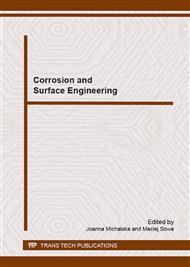p.174
p.178
p.185
p.190
p.194
p.199
p.203
p.207
p.213
The Influence of Waste Expanded Perlite on Chemical Durability of Mortars
Abstract:
Degradation of building materials is an important phenomena influencing its design and utilization. Corrosion of concrete, due to common use of this material is especially important. Chemical corrosion of cementitous materials may be mitigated using various methods. Among them introduction of properly chosen active supplementary cementitous materials to the mix is one of most commonly used. One of possible additives possessing pozzolanic properties is ground waste expanded perlite. No data on the influence of such perlite on chemical durability of cementitous materials can be found in literature. Present paper presents results of investigation on the influence of ground waste expanded perlite on chemical durability of cement mortars. Results obtained showed that there is an improvement of durability of mortars modified with ground waste expanded perlite in sodium sulfate enviroment.
Info:
Periodical:
Pages:
194-198
Citation:
Online since:
January 2015
Authors:
Keywords:
Price:
Сopyright:
© 2015 Trans Tech Publications Ltd. All Rights Reserved
Share:
Citation:


